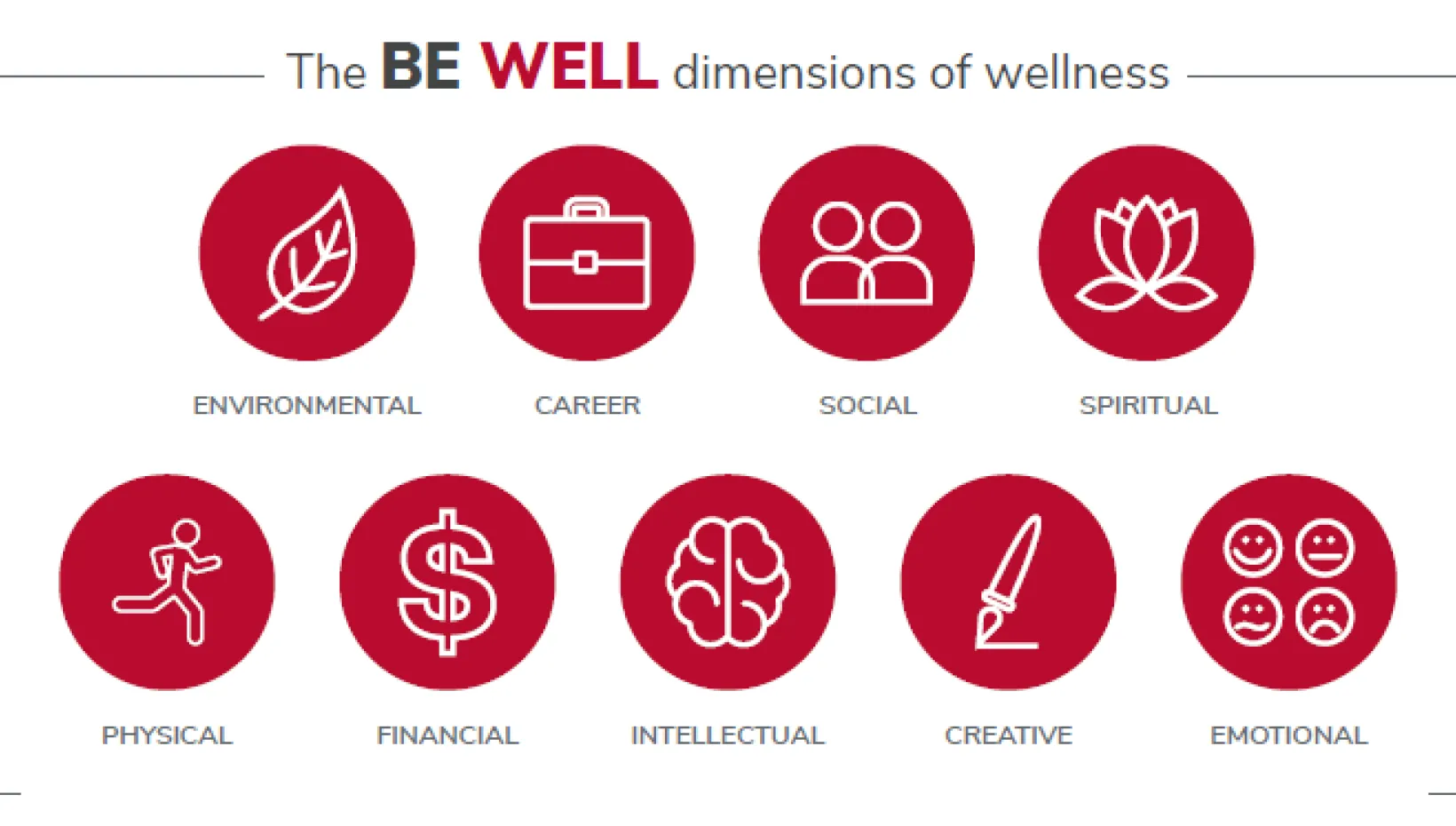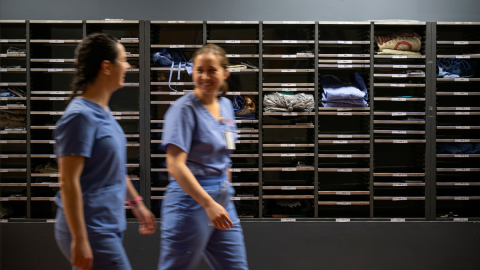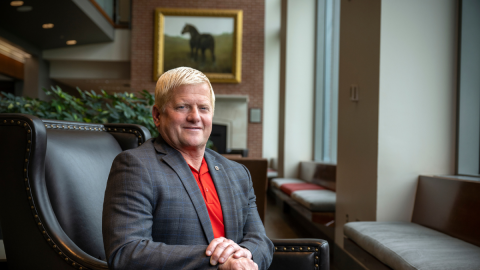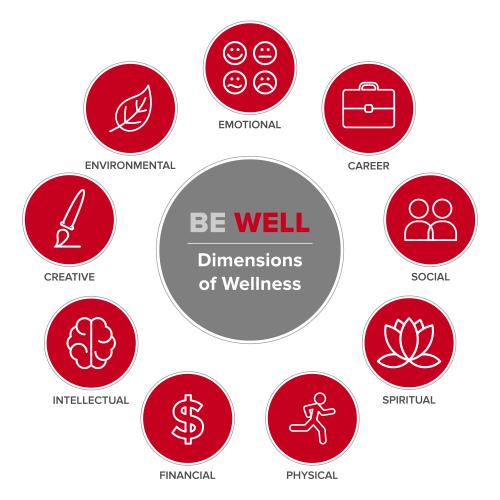Charting a course for veterinarians to be well through evidence-based wellness initiatives

Article by: Allison Burk
Originally Published
Veterinary professionals suffer from compassion fatigue and burnout from working long and often an excessive number of hours, many times barely staying afloat amid a crush of student debt. They too often leave the profession or face mental health crises.
Ohio State’s College of Veterinary Medicine leaders and health and well-being committee comprised of faculty, staff and students are determined to pave the way for students to become not only the most skilled veterinarians in the country but also the most resilient.
Several well-being initiatives have been developed and woven throughout the college’s new four-year curriculum and embedded into the workday to support not only veterinary students but also graduate students, interns, residents, faculty, and staff and to serve as a model for other veterinary colleges.
“We want our people to feel they belong, matter, and can thrive,” said Rustin Moore, DVM, PhD, DACVS, dean of Ohio State’s College of Veterinary Medicine. “We want to remove barriers in their way and equip them with the skills and tools they need to be satisfied, successful and sustainable throughout their professional careers.”
Be Well focuses on nine dimensions of wellness: physical, emotional, financial, spiritual, social, career, intellectual, creative, and environmental. A 10th dimension, focusing on digital wellness, is being added.
Evidence-based and mandatory wellness initiatives
Critical to the success of the College of Veterinary Medicine’s Be Well initiatives is that they are anchored in evidence-based outcomes, meaning that they’ve been proven to work through research.

MINDSTRONG, for example, teaches cognitive behavior skills and has been proven to build resiliency and coping skills among different populations, Moore explains. Data demonstrated a significant improvement in depression and anxiety among first-year students who completed the course, which led to efforts being expanded to interns and residents as well as faculty and staff.
Students attend 45-minute sessions each week for seven weeks, says Brenda Buffington, EdD, a Buckeye Wellness program manager embedded in the College of Veterinary Medicine.
“We care about our college community so much, and we care equally about the veterinary profession. We want to fix what hasn’t been working,” Buffington says. “We’re seeing some great outcomes through the implementation of these initiatives and are serious about making strides toward meaningful impact and change.”
Normalizing mental health care
Also critical are mandatory requirements of each student’s education, especially wellness check-ins, scheduled at stress points before first-year students face their initial exams, and when fourth-year students move from the classroom into hospital-based clinical rotations.
“We wanted to take away the stigma about counselors and make them part of the fabric of the school,” says Emma Read, DVM, MVSc, DACVS, associate dean for professional programs. “It’s taken a lot of the fear away because it’s normalized that almost everyone goes and visits with a counselor at some point, and it’s part of the way that we operate. We encourage them all to take advantage of it throughout their training.”
Addressing well-being through diversity and inclusion
Well-being initiatives must consider the entire individual, and diversity, equity, inclusion and belonging have been part of the foundational principles in the College of Veterinary Medicine’s strategic plan for the past several years, says Mary Jo Burkhard, DVM, PhD, DACVP, associate dean for faculty success and planning.
“There’s more impact on health and well-being for those who are in cultures or come from demographics that are less well represented, and sometimes even marginalized, even in our academic community,” Burkhard says.
Faculty and staff members in underrepresented groups have the responsibility of their positions, but also may be over-tapped to represent those groups on various committees.
“They then get the subtle, and sometimes not-so-subtle, microaggressions and biases, and are also impacted by the things that are happening in the community and society at large,” Burkhard explains.
She says the college addresses internal situations and comments of concern head-on publicly and acknowledges events that happen externally within our society with statements and actions, such as healing forums.
The college also supports affinity groups, largely driven by students and supported by faculty, staff, and administration, that provide a space for community, networking, and mentoring. Examples include the Dr. J.H. Bias Black Affinity Group, a PRIDE group, a women’s group, a parents’ group, and groups for those who are Latinx, Asian, and Native American.
Changing culture through curriculum
Stressors that impact a lifelong career often begin before a student ever steps through the College of Veterinary Medicine doors. At Ohio State, over 2,600 students apply for the 165 open positions each year, Read says. Students may have been focused and competitive for a long period of time, with few social outlets. A first step is encouraging them to view each other as colleagues and friends, rather than competitors.
The new curriculum implemented at the start of the 2022- 23 school year includes a pass-fail system with no letter grades, and Read says it appears it’s already encouraging students to come out of their silos and study together in group sessions.
Faculty sharing observations about experiences with the new first-year curriculum have noted that students appear more relaxed, happier, and healthier, adding that compared with previous years, students seem less run down and have asked more clinically relevant questions, demonstrating more critical thinking.
To help prevent sending students into unsustainable practice models, a goal of the curriculum is to further prepare them not just for medicine and surgery, but also for effectively running a business, collaborating and communicating.
“The implications for well-being are huge, and we’re just starting to make inroads in how we educate and prepare veterinarians and how we teach them to work together and to take care of themselves along the way. We’re trying to change the future of veterinary practice,” Read says.
Easing the financial burden
On top of difficult working conditions, students of veterinary medicine graduate with an extremely large debt load, one that most struggle to pay with the salaries earned in the profession. For every $1 they borrow, they will pay back $2 to $2.5 over the course of the loan.
“Students tell us financial issues are their top stressor, so the more we can prevent their tuition from going up by providing scholarship support and folding in personal financial management strategies as part of the formal curriculum, the better,” Read says.

Moore has committed to not raising tuition more than 2% per year for the past eight years to keep students’ costs down. Additionally, the college has
prioritized fundraising efforts for scholarships and has increased philanthropic scholarships by 730% over the past eight years from $370,000 to nearly $3.1 million for the upcoming academic year.
The goal is to distribute at least $5.8 million a year in philanthropic scholarships, which would enable the college to provide each student, over four years, the equivalent of one year of in-state tuition. When factoring increases in faculty and staff compensation and inflation, this financial model is not sustainable and will require additional support from the state for its only college of veterinary medicine.
The college also began offering an important new resource in April to address the growing issue of food insecurity among veterinary students. The CVM Community Cupboard was established to provide food and other items for students in need on a drop in basis. This resource is made possible through the thoughtful support of several generous and compassionate donors.
Healing a profession in crisis
Tim Kolb, DVM ‘82, has financially supported the college’s wellness initiatives. With 36 years of recovery from substance use disorder, Kolb has worked at the state and national levels to help the industry make strides to ensure professionals with mental health struggles find support early on, instead of potentially losing their licenses or worse.
He’s interacted with many veterinarians in support groups, even more so during the COVID-19 pandemic. While many recover and thrive, it’s given him an opportunity to experience firsthand how much veterinarians are struggling, some with mental health issues, some with burnout.
Kolb, who serves on the college’s admissions committee, says he’d like students who’ve had lifelong dreams of becoming veterinarians, to be able to hold onto some of their idealism and encourages them to ask for support when they need it.
“It just pains me that people at times become so disenchanted with the profession, or their experiences within the profession,” he says. “Being a medical professional in any way is a difficult path, and yet the rewards of it are immeasurable.”
Moore says the College of Veterinary Medicine has been a leader in well-being initiatives on a national level for years, including organizing and hosting the first two veterinary wellness summits in 2012 and 2013, which later became the AAVMC Wellness Summit, a practice that has served to help address this issue through ongoing reflection that ultimately enables the college to pivot and identify areas that need improvement.
“In order to truly ignite change surrounding the longstanding mental health issues that have plagued the veterinary profession, we must push ourselves to do better and be better. If we’re not continually aspiring to Be The Model®, we’re not pushing ourselves enough to change the landscape of veterinary medicine. We will be steadfast in our commitment and dedication to ensuring the health and well-being of our college community and beyond,” he says.
KEY COMPONENTS of the college’s Be Well initiatives are integrated into the comprehensive Be The Model® strategic plan, including:
- Required MINDSTRONG course, which teaches mental health resiliency and coping skills, for first-year students in the summer before classes begin and for interns and residents (postgraduates)upon arrival in their programs
- Two full-time onsite counselors for veterinary students and graduate students
- Mandatory wellness check-ins with a counselor at critical points for veterinary students, one being the first few weeks of the first year before their first exams and the other early in the fourth year as they transition into their clinical rotations
- Prescheduled, opt-out wellness check-ins for interns and residents in advanced training programs
- Onsite part-time psychiatrist for veterinary and graduate students
- Mandatory participation in an annual “Be Well $ Day” financial planning conference for students, onsite financial aid advisor, limits on tuition increases and expanded philanthropic scholarships
- Satisfactory/unsatisfactory (pass/fail) format for all courses throughout the four-year curriculum
- Exercise and meditation/relaxation rooms
- Affinity groups that provide opportunities for connection among members of nondominant groups who self-identify based on certain attributes, backgrounds and experiences
- Crisis placards with QR codes in all bathroom stalls and on business cards distributed to all members of the college
- Mental Health First Aid course to help faculty address student needs
- Health Athlete course focused on energy management, goals and values, for faculty, staff, house officers, veterinary students and graduate students
- Most recently, the college has established the “CVM Community Cupboard” to provide food and supplies for students who are food insecure and/or have other needs
